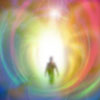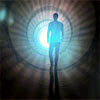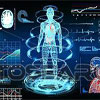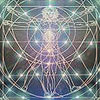The Case For Immortality
 ANCIENT WISDOM UPHELD BY CUTTING EDGE SCIENCE
ANCIENT WISDOM UPHELD BY CUTTING EDGE SCIENCE
By Patrick Marsolek
“When I was fully into the light I realized it was the most incredibly beautiful light that I had ever seen. It seemed to have a personality that was beyond belief-loving. I was happy just being in the light. I remember then that I heard a voice that I thought was the light that surrounded me. Without having a body, somehow I talked to the voice. I was shown that the white light was really made up of all the colors. I was shown the zillions of colors in the light, more than I have seen on earth. They were all beautiful.
“I don’t remember the exact words, but I do remember discussing that all things were made of the light. I asked if even mountains and people were, and the voice (which I now think was God) told me even mountains, and a long list of things, everything. He also told me that the people there were in the light. I don’t remember much about that except that I was aware that people were about to come to take me into some beautiful place and I wanted to go.”— So begins one description of one person’s experience at the edge of death. (Near Death Experience Research Foundation www.nderf.org)
According to a Gallup poll, as many as five percent of the public have had some kind of Near Death Experience (NDE). This is one description from over 1300 that have been compiled since 1998 by Dr. Jeffrey Long on the Near Death Experience Research Foundation website. (www.nderf.org) Dr. Long has recently published the book Evidence of the Afterlife documenting the results of research he has conducted using these reports. He concludes that there is reasonable scientific evidence of an afterlife. This is an impressive statement for a non fiction book that made it as high as 14 on the New York Times bestseller list.
Though the term Near Death Experience is fairly new, coined and popularized by Raymond Moody in the 1970’s, there have been reports of these kinds of experiences throughout history: in early Greek and Roman literature, in early Western religious writings, in the ancient literature of Buddhism, and in the oral history and folklore of aboriginal societies all over the world. The typical NDE experience generally includes some, but not all, of the following elements: separation from the physical body; heightened senses; intense and generally positive feelings; passing into or through a tunnel; encountering a mystical or brilliant light; encountering other beings, often relatives; a life review; encountering unworldly realms; and encountering or learning special knowledge.
NDE’s are a popular topic. There are many books on the subject ranging from scholarly research to personal accounts, all of which have been scoffed at by mainstream scientific researchers. No doubt this book will also spark similar criticism since what NDEs offer goes contrary to the materialistic paradigm that is predominant in our culture. Dr. Long is proposing that there is undeniable and verifiable proof that NDEs are real and they can be studied. I asked him to define what he meant by real. He said, “It is something that actually happened that is part of reality. Anything that is consistently observed is real.” Materialist scientists have staunchly held that the content of NDEs are hallucinatory fabrications of the brain and have no basis in reality.
Dr. Long’s research is based on personal reports collected on the web and does have room for fabrication, exaggeration, and language constraints. Thus it will likely be questioned and challenged for validity. Of course the staunch materialists will ask for physical proof, which is difficult to come by. Yet, it is the consistency and content of the over 1300 reports that have been collected that have convinced Dr. long and led him to propose nine lines of evidence proving that they are real. To briefly summarize, they are:
1–It is medically inexplicable to have a highly organized and lucid experience while unconscious or clinically dead. 2–Experiencers may see and hear in the out-of-body state, and their perceptions are nearly always real. 3–NDEs occur during general anesthesia when no form of consciousness should be taking place. 4–NDEs take place among those who are blind, and these NDEs often include visual experiences. 5–There is a life review of real events, many of which had been forgotten by the individual. 6–Experiencers encounter deceased beings and relatives. 7–The consistency of the experiences of young children with adults suggests NDEs are not due to preexisting beliefs. 8–The reports are consistent around the world from different cultures. 9–Experiences are transformed in profound ways by their experience, often for life.
I’ll look briefly at a couple of these lines of evidence, starting with Out-of-Body (OBE) experiences. OBEs occur in approximately 50% of NDEs. While in the OBE people perceive things they simply couldn’t know by physical means. There are many documented descriptions of events occurring around where the person’s body is, in an operating room or at an accident scene. In one report a woman saw a tennis shoe on a third-story window ledge of the hospital. She described it as a man’s shoe, left footed, dark blue with a wear mark over the left toe. A curious nurse heard the story and looked out through all the windows of the hospital until she did find that shoe exactly as described. In Dr. Long’s research, he claims 97% of the OBE experiences that were described were “entirely realistic without any unrealistic content.”
It is this lucidity that is also one of the hallmarks of the NDE and Long’s first line of evidence. A large percentage of the case reports in his study occurred when the person was clinically dead. In this state, the heart has stopped beating, blood has stopped flowing into the brain, and the electroencephalogram (EEG), which measures brain activity, has gone flat. Though there may still be some lingering electrical activity in the lower parts of the brain, one would expect any conscious experience to be fragmentary, delusional, or dreamlike. Yet 80% of experiencers described their thinking during the NDE as “clearer than usual” or “as clear as usual.” They also often have vivid recollection of these events, continuing for many years after the experience. These experiences contradict the materialist view that consciousness is a product of the brain. If it were so, awareness should be diminished or absent during clinical death. However, this is exactly when many experiencers lucidly report the happenings around their bodies. As the experience progresses, the intensity of their emotions and the clarity of their thinking increases rather than decreases.
As a researcher of other forms of altered states, I find the clarity and consistency of NDEs compelling. In remote viewing, meditation, shamanic journeying, or other forms of altered states, one can have similar experiences: being dislocated from the body, encountering other beings and intelligences, and even having vivid intuitive or clairvoyant perceptions. Yet the contents of these altered states tend to be quite varied and contain elements colored by a person’s belief system and cultural beliefs. These kinds of experiences rarely can be recalled with the clarity of NDEs months and years later or have the same long-term impact on a person’s life. It makes me wonder if it is the complete separation from the physical body and brain that gives rise to the profound clarity and impact of NDEs.
This assertion of separation of consciousness from the body in NDEs seems to support the philosophical thesis of dualism: that mind and matter are independent substances, neither of which can be reduced to the other. Some of the strongest critics of the validity of NDEs are scientists who are also materialists who believe that consciousness is simply an epiphenomenon of the brain. For some materialists, there is no possible evidence that could convince them of something that is false to begin with; hence, there is no point in arguing the matter. The philosopher and NDE research Neal Grossman has suggested that for people whose belief in materialism is more an ideology than a working hypothesis, we could use the term ‘fundamaterialst.’
The verdict of materialistic science is usually that, although the reported NDEs are most certainly real and powerful, they can be explained more easily in terms of the brain and its altered states of consciousness than in terms of consciousness being separate from the brain and interacting with it. This case is often made regardless of the quality and quantity of evidence that it may not be a mechanistic phenomenon. This view is perhaps most strongly argued by neuroscientists, biologists and even psychologists who spend their whole lives in the realm of the physical brain.
A recent proposed explanation for NDEs was published in the Journal of Neurology suggesting that Rapid Eye Movement (REM) intrusions may cause NDEs. Common examples of REM intrusion occur in phenomena such as sleep paralysis and hypnagogia. This research suggested that over 60% of the people who had near death experiences also commonly experience REM intrusion during wakefulness; or more clearly stated, people who have near-death experiences are more likely to find REM-related phenomena intruding on reality. These researchers stated that “even the most complex psychological process is dependent on brain function,” indicating the belief in the primacy of the physical brain over consciousness.
Other physical theories that have been proposed to explain NDEs range from: oxygen starvation; hypoxia; hypercarbia; ischemia; hypoglycemia; temporal lobe epilepsy, and the presence of naturally occurring ketamine in the brain. Some of the mental processes that are offered for explanation are: a reactivation of birth memories, regression to a pre-verbal level as a result of confronting death, and depersonalization.
Dr. Long suggests that the difficulty with all of these explanations, including the REM intrusion hypothesis, is that none of them can explain all of the phenomena of NDEs. These materialist explanations can give no account of how a person acquires accurate information about events remote from his or her body while the person is clinically dead and experiencing no brain activity. Nor can they account for the long-term effects of the experience on people’s lives which is generally not the case from hallucinations, oxygen starvation, and other brain abberations.
The philosopher Neal Grossman has said that the materialist approach “to explaining the NDE is fundamentally misguided.” He says, “It is only with respect to our deeply entrenched materialist paradigm that the NDE needs to be explained, or more accurately, explained away.” He contends that the NDE is “at a minimum, the direct experience of consciousness—or minds, or selves, or personal identity—existing independently of the physical body.”
Not all neuroscientists have such a strong materialist view, though. Mario Beauregard, who authored the book The Spiritual Brain – a Neuroscientist’s Case for the Existence of the Soul with Denyse O’Leary claims “that materialism is out of step with modern physics.” Beauregard and O’Leary propose: “The reason that consciousness is a problem for materialist neuroscience is that it does not appear to have a mechanism. Modern quantum physics conceives of the universe as superimposed states. These states do not exist apart from each other, so their interaction is not governed by a mechanism.” Quantum physics may be shedding light on the possible relationship between the brain and consciousness.
The philosopher B. Alan Wallace goes farther to suggest that mainstream neuroscience’s conviction that consciousness is a phenomenon of the brain and must vanish at death is unfounded. He says, “Given its ignorance of the origins and nature of consciousness and its inability to detect the presence or absence of consciousness in any organism, living or dead, neuroscience does not seem to be in a position to back up that conviction with empirical scientific evidence.”
The mounting evidence for the validity of NDEs is not only stirring up the neuroscientists. Philosophers and theologians also are resisting acceptance of them. Philosophers who are athiests and materialists are doing their best to ignore the evidence of the validity of NDEs. Not only is any hint of dualism suspect, but any research that seems to confirm the presence of a larger loving being or God immediately relegates NDEs to the pseudoscience category. What is equally profound is that many theologians refuse to accept the data. Though NDEs seem to confirm that there is a God, the research also means that science is treading too closely into their domain. Also, the reports of experiencers suggests that God is not vengeful, does not judge us or condemn us, and is not angry at us for our “sins,” which is in direct conflict with some religious beliefs.
Regardless of the quality or quantity of research, a staunch materialist would conclude that the experience was false, simply because it can’t be so. I asked Dr. Long what he thought it would take to convince a materialist of the truth of NDE. “A near death experience cures disbelief in NDEs.” he replied. “About 99% of people who have them are convinced that they are real. Scores of people with doctorate level degrees have had them.” For most experiencers of NDE, the explanation is a non issue. Dr. Grossman writes, “No one who has had an NDE feels any need for an explanation in the reductionist sense that researchers are seeking. For the experiencer… it is exactly what it purports to be.”
In Evidence of the Afterlife, Dr. Long describes how NDEs can be very transformative. Whether a person is an athiest or a believer, a materialist or a dualist, people who’ve had them tend to become much more interested in spiritual matters, loving relationships, and develop a sense of compassion. The effect that a NDE can have on a person’s life is profound. Sometimes, he says, it takes up to seven years to see the full effects, but experiencers may report: less material interest; an increased appreciation of life; a belief in sacredness; a sense of God’s presence; becoming more spiritual or religious; an awareness of deeper meaning or purpose; a belief in the afterlife; no fear of death; increased love of self, others and nature; an increased sense of compassion and empathy; and even physical and emotional healing.
I asked Dr. Long if he thought there was an overarching intention or a purpose to NDEs. He replied, “As far as I can tell, an NDE is a natural expression of what happens when we all die, of that reality that we are all going to be encountering. NDE is a much more clear expression of who we are as conscious beings, apart from the pain of earthly experience, worries and frets. The ego is pretty much set aside during the experience. One thing you get over and over is that there’s an overwhelmingly compassionate and intelligent God that is about choice and creation. I doubt the intent is an endpoint of an expected shift, but to help people understand a certain aspect of reality and then have the potential to make that shift.”
Researcher PMH Atwater has had NDEs and has written several books on the subject. When I asked her the same question, she felt there was more intention in connection to a person’s life, “NDEs always, on some level, meet or address or challenge the needs of the individual at that point in his or her life, even with children.” She went on to say, “The first phrase given by the vast majority of experiencers after their episode is, ‘Always there is life.’ Those four words tell us that there is no afterlife or before life; there is only life, eternal and forever.”
NDEs and the message they bring have risen up again in popular consciousness like the Phoenix rising from the ashes. They are powerfully spiritual experiences that show us we may be transformed at death into something much larger. Also, like the Phoenix, the acceptance of a higher power by new paradigm science may be on the rise. “The strongest line of evidence is the tenth line, the overwhelming consistency of the spiritual content.” Dr. Long said, “It was so powerful and so far reaching, I didn’t feel that it would be appropriate to put in the first book. I didn’t think the world was ready for it, or maybe I wasn’t. But I am now.” If you want to know that spiritual message, you can go online yourself and access all 1300 reports or better yet, talk to someone who has had an NDE and hear how it has affected them.
Patrick Marsolek leads groups and teaches classes in the fields of consciousness exploration, personal development, and healing. He is a clinical hypnotherapist and the author of A Joyful Intuition. See www.ajoyfulintuition.com for more information.
Posted in Life After Death, Life On The Other Side, Near Death Experiencewith comments disabled.





